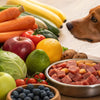Is Kibble or Wet Food Better for Dogs? A Comprehensive Guide for Pet Owners
- Houndsy
Table of Contents
- Introduction
- Understanding Dog Nutrition
- Kibble: The Classic Choice
- Wet Food: The Moist and Tasty Alternative
- Comparing Kibble and Wet Food: Key Differences
- Finding the Right Balance
- Houndsy’s Role in Enhancing the Feeding Experience
- Special Considerations for Specific Dogs
- Conclusion
Introduction
Did you know that a staggering 60% of dogs are considered overweight or obese? This alarming statistic highlights the importance of proper nutrition in maintaining our canine companions’ health. As devoted pet owners, we often find ourselves pondering a fundamental question: Is kibble or wet food better for dogs? With a myriad of options available, navigating the dog food aisle can be overwhelming.
In this blog post, we will delve into the world of dog food, examining the benefits and drawbacks of both kibble and wet food. By the end, you’ll have a clearer understanding of which option might be best for your furry friend, as well as insights into how to make informed feeding choices tailored to their needs. We will also explore how Houndsy’s innovative products, like the Houndsy Kibble Dispenser, can enhance your dog’s feeding experience while aligning with your home’s aesthetics.
Understanding Dog Nutrition
Before we dive into the specifics of kibble and wet food, it’s essential to understand the nutritional needs of dogs. Just like humans, dogs require a balanced diet to thrive, which includes the right proportions of proteins, fats, carbohydrates, vitamins, and minerals. The balance will vary depending on the dog’s age, weight, activity level, and health conditions.
Nutritional Requirements
- Proteins: Essential for growth and repair, proteins are the building blocks of a dog’s body. High-quality sources include meat, fish, and plant-based proteins.
- Fats: Healthy fats provide energy and support cell function. They also help in the absorption of fat-soluble vitamins.
- Carbohydrates: While not strictly necessary, carbohydrates can be a valuable energy source and provide fiber for digestive health.
- Vitamins and Minerals: These micronutrients are crucial for various metabolic processes and maintaining overall health.
By understanding these components, we can better assess the nutritional profiles of kibble and wet food.
Kibble: The Classic Choice
Kibble, or dry dog food, has been a staple in dog diets for decades. Its popularity can be attributed to its convenience, cost-effectiveness, and storage longevity.
Benefits of Kibble
- Convenience: Kibble is easy to measure and portion, making it simple to control your dog's calorie intake. This is especially beneficial for dogs that tend to overeat.
- Storage: Kibble has a long shelf life, often lasting weeks or even months when stored in a cool, dry place. This makes it more practical for busy pet owners.
- Dental Health: The crunchiness of kibble can help reduce tartar buildup on teeth, promoting better oral health.
- Cost-Effective: Generally, kibble is more affordable than wet food, allowing pet owners to save money without compromising on nutrition.
Drawbacks of Kibble
- Moisture Content: Kibble typically contains only about 10% moisture, which may not be sufficient for dogs that don’t drink enough water.
- Less Palatable: Some dogs may find kibble less appealing than wet food, especially picky eaters or those with diminished appetites.
- Potential for Overeating: If not measured correctly, dogs can easily overeat kibble, leading to weight gain.
Wet Food: The Moist and Tasty Alternative
Wet food, also known as canned food, offers a different texture and flavor profile that many dogs find irresistible.
Benefits of Wet Food
- Higher Moisture Content: With moisture levels ranging from 75% to 78%, wet food can help keep your dog hydrated, especially beneficial for those with urinary or kidney issues.
- Palatability: Wet food is often more aromatic and flavorful, making it a great option for picky eaters or older dogs who may have reduced appetites.
- Easier to Chew: The softer consistency of wet food can be easier for dogs with dental problems or those that have difficulty chewing.
Drawbacks of Wet Food
- Shorter Shelf Life: Once opened, wet food must be refrigerated and consumed within a few days, which can lead to food waste if not eaten quickly.
- Cost: Wet food is generally more expensive than kibble, especially when considering the price per calorie.
- Lack of Dental Benefits: Unlike kibble, wet food does not provide any dental health advantages as it lacks the crunchy texture that helps clean teeth.
Comparing Kibble and Wet Food: Key Differences
To determine whether kibble or wet food is better for your dog, let’s explore some key differentiators:
Nutritional Content
When comparing the nutritional profiles of kibble and wet food, it’s essential to look at them on a dry matter basis. Both types can provide balanced nutrition, but there are notable differences:
- Protein Content: Kibble typically has higher protein levels due to the drying process, which concentrates nutrients. However, wet food can still provide adequate protein when measured correctly.
- Fat Content: Both options tend to have similar fat levels, although wet food may include higher fat content for palatability.
- Carbohydrate Content: Kibble usually contains more carbohydrates compared to wet food, which can be beneficial for energy but may not be necessary for all dogs.
Hydration
Wet food excels in hydration due to its high moisture content, making it an excellent choice for dogs that are reluctant to drink water or those prone to urinary issues. Conversely, kibble offers minimal moisture and may require additional water intake to ensure proper hydration.
Taste and Texture
The taste and texture of wet food often make it more appealing to dogs. Wet food can be mixed with kibble to enhance flavor and encourage picky eaters to consume their meals. The combination of both can provide a varied diet that keeps mealtime exciting.
Finding the Right Balance
Ultimately, the choice between kibble and wet food may not be a binary one. Many pet owners choose to feed a combination of both to take advantage of the benefits each has to offer. This approach can provide variety in texture and flavor while ensuring your dog receives adequate hydration.
Mixing Kibble and Wet Food
When mixing kibble and wet food, consider the following tips:
- Gradual Transition: Introduce wet food slowly to avoid digestive upset. Start with a small amount and gradually increase.
- Portion Control: Adjust the amounts of both foods to maintain your dog’s caloric intake. Consult your veterinarian to determine the right proportion based on your dog’s needs.
- Monitor Health: Keep an eye on your dog's weight and overall health, adjusting their diet as necessary based on their activity level and any health issues.
Houndsy’s Role in Enhancing the Feeding Experience
At Houndsy, we understand the challenges of dog feeding and are committed to elevating this daily routine. Our flagship product, the Houndsy Kibble Dispenser, combines mid-century modern design with ergonomic convenience, providing the perfect solution for pet owners.
Features of the Houndsy Kibble Dispenser
- Convenient Crank: Positioned at standing height, our dispenser eliminates the need for bending, making feeding easier on your back.
- Perfect Portion Control: Delivering precise portions every time ensures your dog gets the right amount of food without the risk of overfeeding.
- Large Storage Capacity: With the ability to hold 25–30 lbs of kibble, you can stock up and save trips to the store.
- BPA-Free Liner: Our dispenser features a BPA-free liner to keep food fresh and safe for your furry friend.
- Auto-Locking Mechanism: Designed to prevent accidental dispensing by curious pets or toddlers, our dispenser prioritizes safety.
The Houndsy Kibble Dispenser not only functions effectively but also complements modern home decor, making it a beautiful addition to any space. Explore the Houndsy Kibble Dispenser here.
Special Considerations for Specific Dogs
When deciding between kibble and wet food, it’s vital to consider your dog’s specific needs. Here are a few scenarios:
- Puppies: Growing puppies may benefit from the nutrient density of kibble, but incorporating wet food can enhance palatability and hydration.
- Senior Dogs: Older dogs might appreciate the softer texture of wet food, which can be easier to chew and digest.
- Dogs with Health Issues: For dogs with certain health conditions, such as kidney disease or obesity, consulting with a veterinarian is crucial to determine the ideal diet.
Conclusion
So, is kibble or wet food better for dogs? The answer ultimately depends on your dog’s individual needs, preferences, and any health considerations. Both options can provide balanced nutrition, and mixing them may offer the best of both worlds.
As we continue to explore the joys of pet ownership, let’s not forget the importance of creating a pleasant feeding experience. The Houndsy Kibble Dispenser is here to simplify and elevate that experience, ensuring your furry friend gets the nutrition they deserve in a stylish, functional manner.
What feeding methods have you found to work best for your pup? Share your experiences and let’s continue the conversation!
FAQ
1. Can I mix kibble and wet food?
Yes, mixing kibble and wet food can provide a balanced diet while enhancing palatability and hydration.
2. How should I transition my dog to a new food?
Gradually introduce the new food over 7-10 days, slowly mixing it with their current food to avoid digestive upset.
3. How do I know how much to feed my dog?
Consult your veterinarian to determine the appropriate daily caloric intake for your dog based on their weight, age, and activity level.
4. What are the best brands of kibble or wet food?
Popular recommendations include Hill's Science Diet, Royal Canin, and Purina Pro Plan. Always check with your veterinarian for personalized recommendations.
5. How can I enhance my dog’s feeding experience?
Utilizing products like the Houndsy Kibble Dispenser can improve convenience, portion control, and overall aesthetics while feeding your dog. Explore our Houndsy Kibble Dispenser for a stylish feeding solution.













